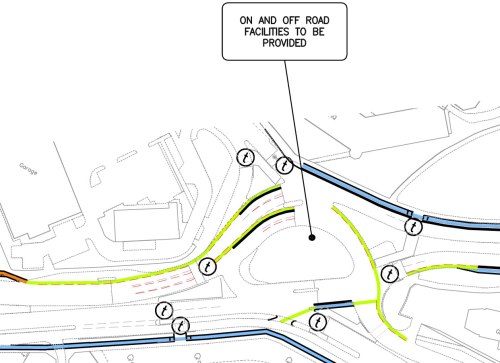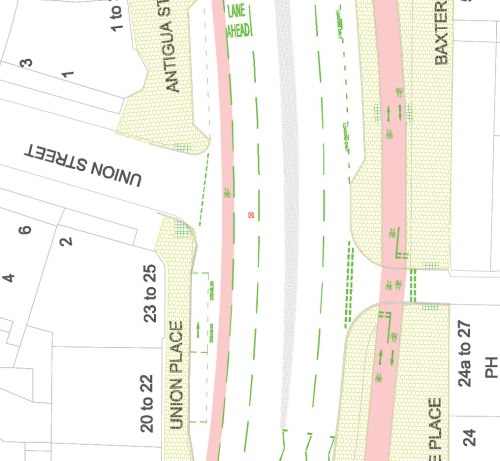Talking to people in Leeds about utility cycling is a bit like trying to explain air conditioning to Eskimos.
I don’t mean to insult the citizens of Leeds here – I was one myself for 30 car-filled years. I love my friends and family, but they have lived their whole lives in a city which has one of the lowest cycling rates in a country with one of the lowest cycling rates in Europe, so you can hardly blame them for driving everywhere and thinking that’s normal and healthy. I understand that from this position the concept of utility cycling can seem baffling and outlandish.
Nor do I criticise anybody in Leeds who uses a car every single time they leave the house. There are few genuine alternatives for most people.
The bus system in Leeds is dominated by one bus company, almost to the point of monopoly, and there is no integrated ticketing system or smart-cards in use. So if you buy a day ticket on a FirstBus bus, you can’t use it on another operator’s bus. You can buy a “Metro Day” which is a ticket issued by the local transport authority, but that costs more and isn’t widely advertised.
As there’s no Oyster equivalent either, each new passenger has to have a conversation with the driver about where they’re going, hand over cash and wait for change. Multiply this by several passengers, or even twenty or thirty people at a busy stop, and you’ll see why a bus journey in Leeds takes much longer than it should.
There’s no metro system, just regular National Rail trains. These are only of use to those who live near a station, and who aren’t in a rush. They’re not the most frequent services either, to say the least, and some of them have certainly seen better days.
The cycling modal share in Leeds is pathetic. Even the commuting share, which tends to be about twice as high as the overall modal share, is around 1%. In the student areas it rises to the giddy heights of 2%.
But this is no surprise, as Leeds City Council has for decades promoted private car use above all else. Not long before I was born, Leeds proudly proclaimed itself to be “Motorway City of the Seventies“. That was actually used as a slogan for the city! You can imagine the sort of schemes they cooked up.
The planning decisions which were made back then have resulted in a dreadful transport environment. Even driving in Leeds is no fun, as the congestion is so bad. (It’s not London, but it’s bad enough.)
Morning Has Broken
However, there is a small ray of light shining through the diesel smog. Like many local authorities across the UK, Leeds, along with conjoined sibling Bradford, is at long last rousing from its 40-year transport slumber, awakened by the delicious aroma of central government money.
The two neighbouring councils have joined forces to come up with a grand plan to create a “cycle super highway” from the centre of Bradford all the way through Leeds to the other side. (If it sounds familiar, that’s because those in charge of Leeds have delusions of grandeur and will copy everything London and Manchester does.)
Someone at the council clearly has a sense of humour, as they’ve called their bid Highway to Health. In it, they’ve used the word “segregated” which is interesting as this wasn’t even on the menu a couple of years ago, but it’s seemingly a word which no cycle plan can be without today.
It promises “segregated, safe cycle lanes, secure cycle parking and activities to encourage cycling and walking” which sounds pretty good. And looking at the plans, they’re considering something which would give those 1970s planners heart attacks: “reduce existing carrigeway to provide cycle track”.
This is actually really encouraging. There’s plenty of space in Leeds for really great cycle infrastructure (not that lack of space is ever a good reason to ignore cycling). They’ve defined two types of cycle track, one Dutch-style and one Danish-style, and they’ve got the general idea right.

Pretty good, but not wide enough. Ideally the elevation of the cycle track would always be halfway between the footpath and the road, as it is in the Type 2 diagram.
They’ve also defined what their bus stop bypasses will look like, and they look pretty good to me.
Part of the route has access roads alongside the main road, and these will be utilised for cycling as part of the plans. This is a great way to get a long stretch of decent cycle route, almost for free, as long as they can discourage as much motor traffic as possible by using alternating one-way restrictions and other methods.
A False Dawn?
Unfortunately, while the general concept is a good one, they seem to have been designed by someone who drives everywhere, although they have watched that video of London’s planned cycle path along the Victoria Embankment. I doubt that those behind the plans have been to the Netherlands to see why cycling works so well over there.
(I acknowledge that these plans are a first draft, merely an attempt to get the funding, and I sincerely hope that the scheme designers take this constructive criticism on board should this project go ahead.)
For a start – and it’s a biggie – their minimum width for a one-way track is only 1.5m, and 2.5m for a two-way track! This is far too narrow, and makes me worry that the whole scheme is about to unravel. The standard minimum for one-way cycle track should be 2m (ideally 2.5m), and 4m for a two-way track. If the current widths are kept, Leeds’ cycle tracks run the very real risk of being seen as toytown infrastructure, dangerously narrow, and a waste of money.
It also looks like they’re planning for full-height vertical kerbs, which reduce the usable width of the cycle track by quite a margin. It sounds like a silly little detail, but it’s really not. Kerbs need to be suitable for safe cycling, and the standard UK road kerb isn’t good enough.
Toucan play at this game
Also worrying is the number of toucan crossings (combined cycling-and-walking crossings). They’re nearly always fiddly for bike users and confusing or unnerving for those walking. If we must sometimes put the two modes together, parallel cycling/walking crossings are legal, so why can’t we use those?
I’m not sure about their concept for when a cycle track meets a pedestrian crossing either. What happens if people are waiting at the crossing? Do bike users have to wait until the crossing is clear, or are they expected to swerve onto the footpath? Are people on foot expected to press the button then take a few steps back?
The Netherlands has solved these problems, we need to copy their designs rather than waste time and money with rubbish like this:
Here’s one in action, near Leeds train station:
Well I say “in action” but this design only really works because so few people cycle in Leeds that the chances of a pedestrian meeting a person on a bike here are infinitesimally slim.
(Incidentally, the cycle tracks near the station are of a pretty high quality for the UK. It’s just a shame that they’re so very short and of limited use. Added July 2014: I say they’re good “for the UK” which is faint praise – they still have some severe flaws, as described in this Reddit conversation.)
Dutch-style junctions? We’ve heard of ’em
They seem to be having terrible trouble getting junctions right. Whoever drew these plans really needs to visit the Netherlands, as all the situations have been solved already. The current plans involve a mixture of ASLs, painted cycle lanes and toucan crossings, which simply isn’t good enough.
Again, the Dutch have existing, working solutions for all of these junctions. Why not copy them?

I’ll be honest: this doesn’t scream “convenient” to me. (See it on Google Maps)
Do you think there might be a better solution here? Even though Dutch-style roundabouts are still undergoing trials, why not provide a single-stage straight-through crossing?
Note to traffic engineers: IT IS VERY DIFFICULT TO DO A 90º-TURN ON A BIKE.
Here’s another junction:

“We didn’t know what to do here. Will this do?” (See it on Google Maps)
I like the phrase “on and off road facilities to be provided” which is traffic planner code for “this looks hard, and we didn’t know what to do, so we’ll put ‘confident cyclists’ on the road, and everyone else will just go on the path.”
I know this junction well, and I can tell you that the proposed design is a mess. They really need to go back to the drawing board on this one. It’s really not that complicated (it was a roundabout until about ten years ago) but they’ll need to put in some cycle-specific signals to fix it. Dare they make the cars wait?
And a final junction:

Nice cycle paths, shame about the junction. Also note lack of any facility for turning right, other than cycling across multiple lanes of motor traffic. (See it on Google Maps)
This junction really isn’t that complicated, there’s no excuse for giving up on the cycle paths and putting in painted lanes instead. They may as well do nothing and cross their fingers. Junctions are where good cycle path design is needed most!
Oh Bradford, where art thou?
I must reserve my ire for Bradford though, as they’re letting the whole thing down. Their side of the scheme looks largely to be business as usual, with long stretches of “on-carriageway cycling”. If you’re lucky, there will be a painted cycle lane.
The section below is on Leeds Old Road, which is a wide road with a painted central strip. There is plenty of space for a proper cycle track. Bradford aren’t even trying.

Thanks for nothing, Bradford. (See it on Google Streetview)
They’re even suggesting “cycle on carriageway” at the enormous multi-lane Thornbury Gyratory, which is ridiculous and shows that they really don’t care about cycling.

This junction is HUGE, and all they’re suggesting is cycle lanes? Look at it on Google Maps. LOOK AT IT NOW.
Maybe Bradford is secretly hoping to become the new Motorway City of the Seventies.
In conclusion: possibly
Overall though, the scheme is a huge leap forward, and a world away from the usual cycle provision of bus lanes, blue signs and apathy (well, the Leeds side is, anyway – Bradford really needs to get with the programme). It’s physically a huge scheme too, crossing right from one end of the city to the other.
This is no complete solution, however. It’s still nowhere near the dense network of cycle paths and nearly-traffic-free streets which are required for mass cycling, and there are many details which need to be fixed.
But there are very many good points also, and the general concept is the right one – provide safe, protected space for cycling, away from motor vehicles.
With some alterations (fix the junctions, widen the tracks) then maybe – just maybe – Leeds can finally begin to leave the 1970s behind and one day become a 21st century European city.
Manchester is also up to something which is good but could be better. Two schemes, in fact – this one in the city centre and this one on Oxford Road. You can take a look and tell the council how to do it right – even if you don’t live there you can respond.
















 The Alternative Department for Transport is written by, and the personal opinion of,
The Alternative Department for Transport is written by, and the personal opinion of, 


